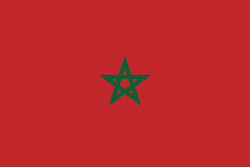Tangier Ibn Battouta Airport (Tangier Ibn Battouta Airport)
Tangier Ibn Battuta Airport (Aéroport de Tanger-Ibn Battouta, مطار طنجة ابن بطوطة) is an international airport serving Tangier (Tanger in French), the capital city of the Tanger-Tetouan-Al Hoceima region in Morocco. The airport is named after Ibn Battouta (1304–1368), a Moroccan traveler who was born in Tangier. The airport was formerly known as Tanger-Boukhalef Airport. The airport handled over 1,070,247 passengers in the year 2017.
A new airport terminal building was opened in 2008 to provide for many more flights and increased passenger capability, as Tangier has grown rapidly and modernised.
Aircraft parking space of 40640 m² supports up to four Boeing 737s and one Boeing 747. For small craft two dedicated sections are assigned. The air terminal is 12000 m² and designed to handle 1,250,000 passengers per year. The cargo terminal is 529 m² of covered space.
The airport has two runways but only the longer runway is in active use and 07/25 is closed. The 3500 meter long runway 10/28 is open and is capable of handling all sizes of aircraft up to the size of a Boeing 747 and Airbus A380-800.
The airport has an ILS status (Loc – Glide – DME) and offers the following radionavigational aids: VOR – DME – NDB. PAPI lighting available for runway 10/28 for approaches from either direction.
Tangier-Ibn Battouta is one of the six airports in Morocco where ONDA offers its special VIP service Salon Convives de Marque.
A new airport terminal building was opened in 2008 to provide for many more flights and increased passenger capability, as Tangier has grown rapidly and modernised.
Aircraft parking space of 40640 m² supports up to four Boeing 737s and one Boeing 747. For small craft two dedicated sections are assigned. The air terminal is 12000 m² and designed to handle 1,250,000 passengers per year. The cargo terminal is 529 m² of covered space.
The airport has two runways but only the longer runway is in active use and 07/25 is closed. The 3500 meter long runway 10/28 is open and is capable of handling all sizes of aircraft up to the size of a Boeing 747 and Airbus A380-800.
The airport has an ILS status (Loc – Glide – DME) and offers the following radionavigational aids: VOR – DME – NDB. PAPI lighting available for runway 10/28 for approaches from either direction.
Tangier-Ibn Battouta is one of the six airports in Morocco where ONDA offers its special VIP service Salon Convives de Marque.
| IATA Code | TNG | ICAO Code | GMTT | FAA Code | |
|---|---|---|---|---|---|
| Telephone | Fax | ||||
| Home page |
Map - Tangier Ibn Battouta Airport (Tangier Ibn Battouta Airport)
Map
Country - Morocco
 |
 |
| Flag of Morocco | |
In a region inhabited since the Paleolithic era over 300,000 years ago, the first Moroccan state was established by Idris I in 788. It was subsequently ruled by a series of independent dynasties, reaching its zenith as a regional power in the 11th and 12th centuries, under the Almoravid and Almohad dynasties, when it controlled most of the Iberian Peninsula and the Maghreb. In the 15th and 16th centuries, Morocco faced external threats to its sovereignty, with Portugal seizing some territory and the Ottoman Empire encroaching from the east. The Marinid and Saadi dynasties otherwise resisted foreign domination, and Morocco was the only North African nation to escape Ottoman dominion. The 'Alawi dynasty, which rules the country to this day, seized power in 1631, and over the next two centuries expanded diplomatic and commercial relations with the Western world. Morocco's strategic location near the mouth of the Mediterranean drew renewed European interest; in 1912, France and Spain divided the country into respective protectorates, reserving an international zone in Tangier. Following intermittent riots and revolts against colonial rule, in 1956, Morocco regained its independence and reunified.
Currency / Language
| ISO | Currency | Symbol | Significant figures |
|---|---|---|---|
| MAD | Moroccan dirham | د م. | 2 |
| ISO | Language |
|---|---|
| AR | Arabic language |
| FR | French language |















